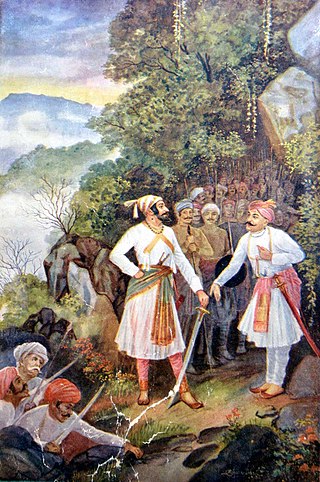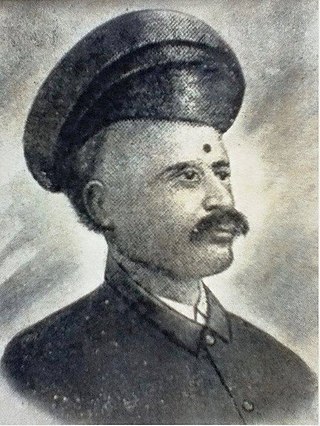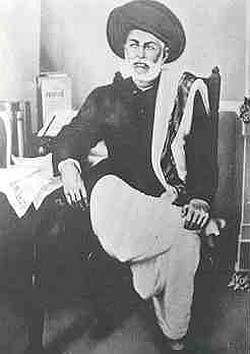This article needs additional citations for verification .(March 2015) |
The Konkan Division is the administrative division in the coastal region of the Indian state of Maharashtra. It has a diverse number of ethnic and religious communities.
This article needs additional citations for verification .(March 2015) |
The Konkan Division is the administrative division in the coastal region of the Indian state of Maharashtra. It has a diverse number of ethnic and religious communities.

The Konkan, also Concan or Kokan, is a stretch of land by the western coast of India, running from Damaon in the north to Anjediva in the south; with the Arabian Sea to the west and the Deccan plateau in the east. The hinterland east of the coast has numerous river valleys and riverine islands among the hilly slopes leading up into the tablelands of the Deccan. The region has been recognised by name, since at least the time of Strabo in the third century C.E., and was a thriving mercantile port with Arab tradesmen from the 10th century. The best-known islands of Konkan are Ilhas de Goa, the site of the Goa state's capital at Panjim, and the seven islands of Bombay, on which lies the capital of the state of Maharashtra.main kokan starts from Alibag and ends with goa. There is most sacred place in kokan of goddess padmakshi renuka temple in Alibag, this goddess is shaktipeeth among 108 peethas where sati goddess brain part is fallen. some people also recommend that devi sati's nails fallen but this goddess is also called goddess of kokan.

Pathare Prabhu is one of the Hindu communities in the city of Mumbai.

The Siddi, also known as the Sheedi, Sidi, or Siddhi, or Habshi are an ethnic group inhabiting India and Pakistan. They are primarily descended from the Bantu peoples of the Zanj coast in Southeast Africa and Ethiopia, most whom arrived to the indian subcontinent through the Arab Slave Trade. Others arrived as merchants, sailors, indentured servants, and mercenaries. The Siddi population is currently estimated at around 850,000 individuals, with Karnataka, Gujarat and Hyderabad in India and Makran and Karachi in Pakistan serving as the main population centres. Siddis are primarily Muslims, although some are Hindus and others belong to the Catholic Church.
Saraswat Brahmins are Hindu Brahmins, who are spread over widely separated regions spanning from Kashmir in North India to Konkan in West India to Kanara and Kerala in South India. The word Saraswat is derived from the Rigvedic Sarasvati River. Most of Sarswat Brahmins are on Rajasthan north side, Haryana south side and most places on Punjab.

The East Indians, also called East Indian Catholics or Bombay East Indians, are an ethno-religious Indian Christian community native to the Seven Islands of Bombay and the neighbouring Mumbai Metropolitan Area of the Konkan division.
Chandraseniya Kayastha Prabhu (CKP) is an ethnic group mainly found in Maharashtra. Historically, they made equally good warriors, statesmen as well as writers. They held the posts such as Deshpande and Gadkari according to the historian, B.R. Sunthankar, produced some of the best warriors in Maharashtrian History.
This article is about the caste system in Goa, and describes the various Jātis or sub-castes to be found among Hindus belonging to the four varnas, as well as those outside of them. A variation of the traditional Hindu caste system was also retained by the Goan Catholic community, and hence their castes are also mentioned in this article.

Battle of Pävankhind was a rearguard last stand that took place on 13 July 1660, at a mountain pass in the vicinity of fort Vishalgad, near the city of Kolhapur with the Maratha warrior Baji Prabhu Deshpande and Sambhu Singh Jadhav against Siddi Masud of the Bijapur Sultanate. The engagement ended with the destruction of the Maratha forces, and a tactical victory for the Bijapur Sultanate that failed to achieve a strategic victory.
Prabhu means master or the Prince in Sanskrit and many of the Indian languages; it is a name sometimes applied to God. The term is also used by devotees of the Hindu God Lord Krishna/Vishnu as a title and form of address. It is also appended after a devotee's name, for example "Madhava Prabhu". In Indonesia, especially in Balinese, Javanese, and Sundanese culture, the term "Prabu" is used as a part of royal titles, especially to address Kings such as Prabhu Siliwangi, Prabu Kiansantang, etc.
The Dalvi is an Indian surname derived from the name of a clan found among the Saraswat Brahmin, Maratha, Koli and Pathare Prabhu communities of Maharashtra.

Shivkar Bāpuji Talpade was an Indian instructor in the Sir JJ School of Art with an interest in Sanskrit and in aviation. He lived in Mumbai, and is claimed to have constructed and flown an unmanned, heavier-than-air aircraft in 1895. Contemporary accounts of a successful flight do not exist, and no reliable historical records document its existence.

Satyashodhak Samaj was a social reform society founded by Jyotiba Phule in Pune, Maharashtra, on 24 September 1873. It espoused a mission of education and increased social rights and political access for underprivileged groups, focused especially on women, peasants, and Dalits, in Maharashtra. Jyotirao's wife Savitribai was the head of women's section of the society. The Samaj disbanded during the 1930s as leaders left to join the Indian National Congress party.
Roman Catholic Brahmin is a caste among the Goan, Bombay East Indian and Mangalorean Catholics who are patrilineal descendants of Konkani Brahmin converts to the Latin Catholic Church, in parts of the Konkan region that were annexed into the Portuguese East Indies, with the capital (metropole) at Velha Goa, while Bombay was the largest territory (province). They retain some of the ethno-social values and customs of their ancestors, and most of them exhibit a noticeable hybrid Latino-Concanic culture. They were known as the Brahmins among the "New Christians".

Maharashtra is the third largest state of India in terms of land area and second largest in terms of population in India. It has a long history of Marathi saints of Varakari religious movement, such as Dnyaneshwar, Namdev, Chokhamela, Eknath and Tukaram which forms the one of bases of the culture of Maharashtra or Marathi culture. Maharashtra had huge influence over India under the 17th-century king Chatrapati Shivaji Maharaj of the Maratha Empire and his concept of Hindavi Swarajya which translates to self-rule of people.

Keshav Sitaram Thackeray, was an Indian social reformer. He campaigned against superstitions, untouchability, child marriage and dowry. He was also a prolific author.
Panchkalshi is a Hindu community. They are one of the original native communities of Bombay (Mumbai) metropolitan area in the Konkan division of India. Since the 19th century the community has called itself Somvanshi Kshatriya .
Gramanya refers to a dispute or discussion related to castes in Maharashtra in the past few centuries that related to supposed violation of the Brahmanical ritual code of behavior.
The Pathare Prabhu Kanchole caste is one of the two sections of the original Pathare Prabhu caste of Mumbai. The Pathare Prabhus had settled in Mumbai, and the region thereabout in the 13th century, and gained prosperity during the development of Bombay by the British in the 18th century. The Pathare Prabhu Kancholes are a few hundred in number, and this section came into existence, within the major caste, in the year 1777, over a quarrel on the occasion of a marriage ceremony in the caste. This smaller section of the main caste is known as Kanchole Pathare Prabhus, as the dispute leading to the schism in the original caste had centred about a kanchole, i.e. a small vessel used for holding sandalwood paste for the purpose of anointing, in honour, the foreheads of guests.
The Prabhu communities are a group of related Hindu castes found in Maharashtra, India. There are four such castes, all having different ritual and social status within the caste system of Maharashtra. They are Chandraseniya Kayastha Prabhu, Pathare Prabhu, Kanchole Prabhus and the Danved Prabhu.